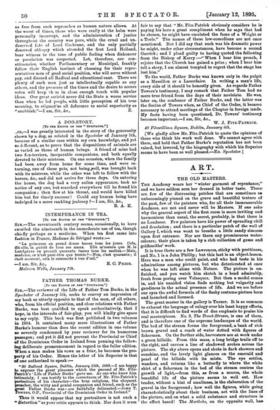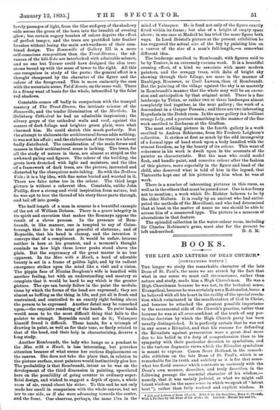ART.
THE OLD MASTERS.
THE Academy wears her "winter garment of repentance," and we have seldom seen her dressed in better taste. There, are few of the distressing patches that are sometimes so unbecomingly pinned on the grave and beautiful texture of the past, few of the painters who, for all their immeasurable deadness, are not and never will be Masters. If one asksi why the general aspect of the first room is more inviting and harmonious than usual, the secret, probably, is that there is no Landseer. Few painters have his power of spreading chill and desolation ; and there is a particular patch of the wall of Gallery I. which was wont to breathe a little sandy simoorm upon first entrance. Nor are there any promiscuous water- colours; their place is taken by a rich collection of gems and goldsmiths' work.
It is true there are a few Lawrences, sticky with prettiness,. and No. 1 is a John Phillip ; but this last is an object-lesson. Here was a man who could paint, and who had taste in his admirations among pictures, but who deteriorated at once when he was left alone with Nature. The picture is un- finished, and you watch him sketch in a head admirably,. fresh from poring over Velasquez. But then a model comes in, and his unaided vision finds nothing but vulgarity and gaudiness in the actual presence of life. And we see before our eyes the awful formula of the flashy costume-picture born and launched and licensed.
The great master in the gallery is Turner. It is so common to exhaust the language of eulogy over his least happy efforts, that it is difficult to find words of due emphasis to praise hie real masterpieces. No. 8, The Trout-Stream, is one of them, and is therefore one of the supreme landscapes of the world.._ The bed of the stream forms the foreground, a bank of rich brown gravel and a reach of water dotted with figures of fishermen. On the further side, harvesters are at work under a green hillside. From this mass, a long bridge trails off to the right, and carries a line of shadowed arches across the picture. The sky above opens and shuts in dark showers and sunshine, and the lovely light glances on the emerald and pearl of the hillside with its mists. The eye settles, wanders, and returns like a butterfly to where the white shirt of a fisherman in the bed of the stream centres the growth of Egli k—from this, as from a source, the whole beautiful life of the picture seems to well out. How, tender, without a hint of smallness, is the elaboration of the gravel in the foreground ; how well the figures, while going characteristically about their business, act with the lines of the picture, and on what a solid substance and structure is the effect based! The Mortlake, on the opposite wall, has
dovely passages of light, from the lilac and grey of the shadowy =aide across the green of the lawn into the breadth of evening
:glow; but certain sugary touches of colour deprive the effect of perfect temper, and the trees are prettified into feather ,rushes without losing the main awkwardness of their com- bined design. The Bonneville of Gallery III. is a more -self-conscious composition than the Trout-Stream ; the ad- vances of the hill-fists are interlocked with admirable science, and no one but Turner could have designed the slim tree- 'stems bound up with the mass of tower to the right. All this one recognises in study of the parts ; the general effect is a 'thought cheapened by the character of the figure and the .colour of the foreground. This is more eminently the case with the mountain scene, Val d' Aouste, on the same wall. There is a flimsy want of basis for the whole, intensified by the false red shadows.
Constable comes off badly in comparison with the tranquil mastery of The Trout-Stream, the intricate science of the Bonneville, and the tender illumination of the Mortlake. In 6alisbury Cathedral he had an admirable inspiration ; the silvery greys of the cathedral walls and roof, against the masses of dark foliage and brighter green plain, were what -charmed him. He could sketch this much perfectly. But the attempt to elaborate the architectural forms adds nothing;
was not his affair ; and the elaboration of the trees is a labour 'badly distributed. The consideration of the main forms and masses in their architectural sense is lacking. The trees, for all the study of nature in them, are almost as stupid as the awkward paling and figures. The colour of the building, the green lawn drenched with light and moisture, and the idea -of a framework of dark trees, are the picture, incrusted and ,distorted by the obsequious note-taking. So with the Dedham Vale ; it is a big idea, with fine notes buried and worried in it. There are false notes too in the colour. The third large picture is without a coherent idea. Constable, unlike John Phillip, drew a strong and vivid inspiration from nature, but the was apt to lose the thread of his story three parts through, and tail off into gossip.
The half-length of a man in armour is a beautiful example -of the art of William Dobson. There is a grave integrity in its spirit and execution that makes the Romneys appear the result of a clever process. In the presence of Rem. brandt, in like manner, one is tempted to say of Gains- !borough that he is the most graceful of slatterns ; and of Reynolds, that his hand is clumsy, and the intention it conveys that of a compliment. It would be unfair, because neither is here at his greatest, and a moment's thought (reminds us how high these lower peaks stand above the plain. But the supremacy of the great master is no lees :apparent. In the Man with a Hawk, a head of adorable beauty is set in a frame of golden light, and by its radiant emergence strikes upon the mind like a visit and a vision. The pippin face of Nicolas Berghem's wife is handled with another feeling, but with an understanding and mastery so .compete that it would be hard to say which is the greater picture. The eye can barely follow in the paint the modulo- tions by which the forms of the head are expressed; they are almost as baffling as the thing in life, and yet all is fresh and unstrained, and controlled to an exactly right feeling about the person to be expressed Another detail may be remarked 'upon,—the exquisite rendering of the hands. To paint hands would seem to be the most difficult thing that falls to the painter to attempt. Reynolds could not do it; Velasquez himself found it difficult. These hands, for a triumph of 'drawing in paint, as well as for their tone, so finely related to that of the head, and their help in characterising, deserve a long study.
Another Rembrandt, the lady who hangs as a pendant to the Man with a Hawk, is less interesting, but provokes attention because of what seems her curious displacement on the canvas. She does not take the place that, in relation to the picture surface, most painters would instinctively give her. The probability is that Rembrandt, intent as he was on the development of the third dimension in painting, speculated here on the possibility of going counter to ordinary super- ficial design, and wished to suggest a depth of space, a whole room of air, round about his sitter. To this end he not only .sciade her small in comparison with the whole canvas, but set 4ier to one side, as if she were advancing towards the centre, and the front. One observes, perhaps, the same i?ea in the mind of Velasquez. He is fond not only of the figure exactly fitted within its frame; but also of a height of empty space above ; in one case at Madrid he has tried the same figure both ways. In Lord Bristol's picture at the present exhibition he has suggested the actual size of the boy by painting him on a canvas of the size of a man's full-length,—a somewhat different idea.
The landscape ascribed to Rembrandt, with figures said to be by Teniers, is an extremely curious work. It is a beautiful evening effect, of a kind we associate with more modern painters, and the scraggy trees, with dabs of bright sky showing through their foliage, are more in the manner of Daubigny, Rousseau, or Cecil Lawson, than of Rembrandt. But the painting of the village against the sky is so masterly in Rembrandt's manner that the whole may well be an excur- sion and anticipation by that original mind. There is a fine landscape by Titian, or rather two or three landscapes almost completely tied together, in the next gallery ; the work of a descendant in a Gaspar Poussin ; and there are two interesting Ruysdaels in the Dutch room. In the same gallery is a brilliant orange Lely, and a portrait something in the manner of the fine work ascribed to Zarbaran at the Grafton.
The most striking picture in the fourth gallery is a work ascribed to Andrea Schiavone, from Sir Frederic Leighton's collection. It strikes at first as much by the odd incongruity of a formal type of head stuck upon a body handled with the utmost freedom, as by the beauty of its colour. This want of coherence in his work is dwelt upon in the accounts of the painter as characteristic. But the man who could model flesh, and handle paint, and conceive colour after the fashion of this picture, more especially in the figure and head of the child, also deserved what is told of him in the legend, that Tintoretto kept one of his pictures by him when he was at work.
There is a number of interesting pictures in this room, as well as in the others that must be passed over. One is too funny not to mention ; a work which Dr. Richter believes to be by the elder Holbein. It is really by an ancient who had antici- pated the methods of the Morelliani, and who had determined that at least in the matter of noses no one should be able tc accuse him of a mannered type. The picture is a museum of aberrations in that feature.
The splendid collection in the water-colour room, including Sir Charles Robinson's gems, must also for the present be



































 Previous page
Previous page